By the Eminent American Piano Virtuoso
WILLIAM H. SHERWOOD
A few days ago an estimable lady, who has been one of my neighbors, asked, “Who do you consider the greatest composer? Is it Verdi?”
Naturally, I answered that I considered several composers greater than Verdi, naming Bach, Beethoven, Schumann, Mendelssohn, Liszt, Wagner and others. My neighbor is very fond of music and has heard the works of most of the great masters. Therefore, her question set me to thinking and led to the conclusion that people who do not depend upon music for a living, as well as those who do not look to it for higher intellectual enjoyment, unconsciously love the simple, beautiful melodies such as those found in Italian operas far better than the works of the composers mentioned above, the works of whom, in many cases, require the hearer to possess trained intellectual, aesthetic and emotional faculties before they may be appreciated. The difficulty with much Italian operatic music is that “it sounds better than it is.” Our own genial Mark Twain has said of certain music: “They tell me it is much better than it sounds.” The difficulty with much Italian operatic music is that “it sounds better than it is.” Notwithstanding this there is much in the older Italian operatic music that will prove of permanent value as long as the art exists.
Such writers as Verdi, Donizetti and Rossini composed melodies of great beauty, and these masters also showed appreciation of dramatic possibilities in their works. Such operas as “William Tell,” “La Sonnambula,” “Il Trovatore,” “Moses in Egypt” and “Rigoletto” bid fair to hold the boards as long as any opera of any school, whether written before or since.
When speaking of transcriptions for the piano, the name of Liszt naturally comes first to the mind. It is doubtful if any such whole-souled, generous nature will ever again exist among musical geniuses. What Liszt did for the music of the most widely different schools (through his peerless playing and arranging) has never been excelled and scarcely equaled. Liszt’s piano arrangements of Bach’s organ music are as much a standard to-day as when they were first written. Liszt’s arrangements of Schubert’s songs did as much as anything else to popularize the beautiful melodies of this genius among song writers. Liszt’s arrangements of Wagner selections are equally, or still more, in the foreground. It is well known that Liszt gave both time and money, his best strength and influence to help Wagner. He paid Wagner’s debts and finally saw his music successfully brought before the public. The result was that his music dramas revolutionized the world of art. All of this Liszt did without remuneration or expectation of reward.
LISZT’S ARRANGEMENTS.
I have frequently felt that Liszt made decided improvements upon the original in his paraphrasing of works from Italian operas. In his “Miserere,” from “II Trovatore,” he has relieved the music by strokes of genius in added parts and modulations, and all in such a manner as to enhance the artistic feeling and spirit of the original. To those accustomed to the polyphonic and intellectual work of the great northern composers there are undoubtedly threadbare passages in the original Italian works, where the tedium of hackeyed (sic), commonplace accompaniment and ordinary harmonies is unrelieved. At such moments Liszt knew how to put just the right additional touch, in the proper spirit. He did not spoil the works by overloading them with his own intellectuality to an offensive degree. To illustrate his spirit of fidelity and appropriate appreciation of the composer’s genius, it is worth while to mention an incident which occurred during my studies with Liszt. Miss Anna Mehlig (the German pianiste) was the only other one present with myself when, one day Liszt played several “Etudes” from Chopin, commenting upon their value as studies and their rare beauty as compositions of the highest order. An arrangement by Brahms of the “Etude in F Minor” (Op. 25, No. 2) was characterized as being over-elaborated, Brahms having doubled the principal part (originally written for the right hand with a single “voice” of running melody) by inventing an etude in sixths and thirds, meanwhile making greater demands upon the left hand by doubling and magnifying the parts of harmony and accompaniment. Liszt made strenuous objections to departing to such an extent from the musical meaning and simple beauty of the original, saying that if anybody wished to write an etude in thirds and sixths and other difficulties he had better compose a new piece of music himself, instead of spoiling a beautiful work of genius like that of Chopin. His idea might be compared to the inappropriateness of trying to make a sunflower out of a daisy.
Many other pianists have made “arrangements” and paraphrases of the works of great composers. Tausig gave us masterly examples of piano arrangements from Bach, Wagner, Von Weber and Strauss. Von Bülow arranged, in a most beautiful way, the “Quintette” from “Meistersinger” of Wagner. We have the “Magic Fire” from “Die Walküre” arranged splendidly by Brassin. Recent adaptations of different organ works of Bach have been carried out in a most masterly manner by Busoni.
One of the best efforts of our American composer, Gottschalk, can be seen in his arrangement of the “Miserere” from “II Trovatore.” In this we see much evidence of the effectiveness with which Gottschalk bewitched his audiences. In the first cords (to be played as short as though they were picked on the strings of the violin) we find a sonorous melody. This page makes a useful study, to help one learn how to discriminate so as to play two or more tones of unequal dynamic force, with the same hand and at one stroke. If the pedal be used sufficiently late after the attack upon the chord to avoid sustaining the short accompaniment notes, but so as to maintain the sound of melody notes until the next interval, the result will be good. A study of dynamic effects and correct, independent control of the damper pedal is hereby afforded and is well worth the student’s attention. (See illustration I.)
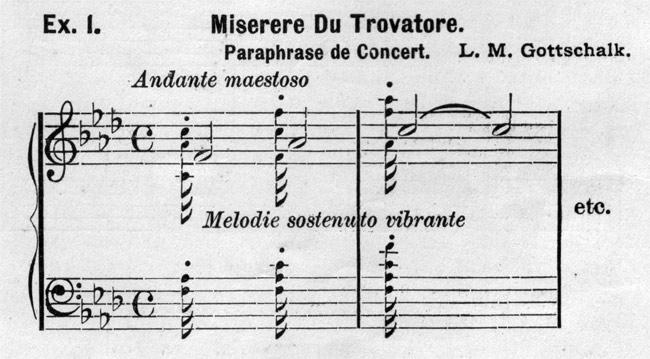
The dynamic effect of playing the notes of the well-known melody “I Have Sighed to Rest Me,” with brilliant octave embellishments, shows modern and highly effective devices, which Gottschalk knew how to use to the fullest advantage in his concert playing. If the melody part is played and sustained with sufficient volume and the octaves are played with sufficient lightness of touch, the dynamic effect (with the aid of the damper pedal) can be made good, notwithstanding the temporary dissonance caused through the pedal. Much depends upon good judgment and taste in shading the tones.
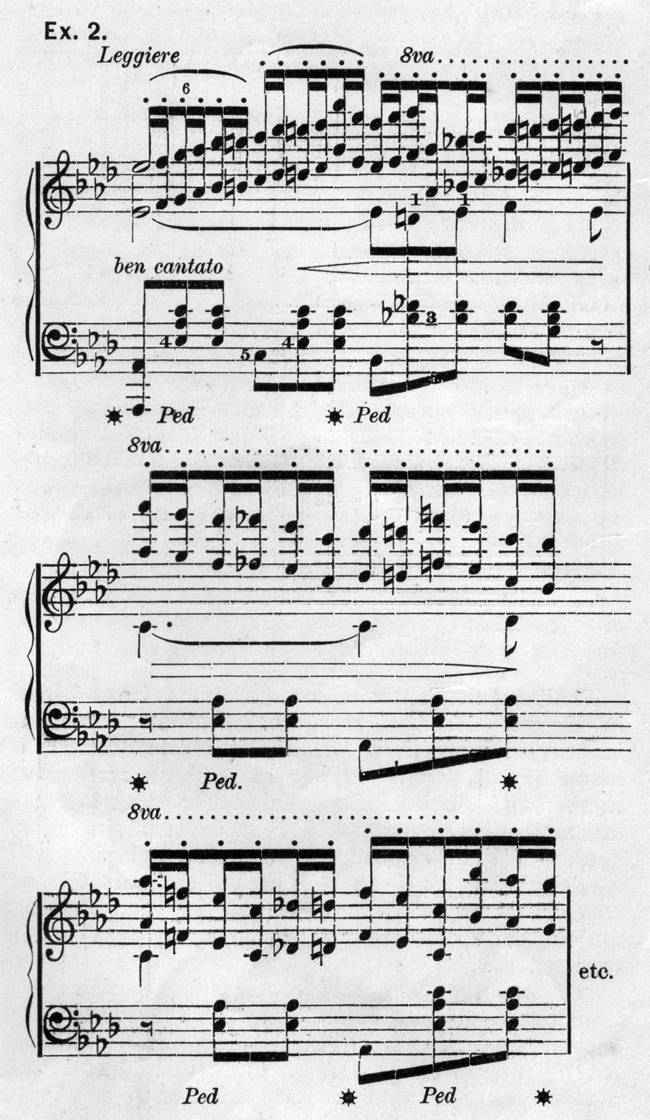 Charles Kunkel has transcribed the “Overture” to “William Tell.” In this number we have the grace and mellow sweetness of the harmonious and tuneful “Pastorale” and “Shepherd Song” well provided for, while the “Storm” episode is arranged for the piano with a view to obtaining the utmost sonority and an appropriate and thrilling “wildness” by the most simple and practical means. This is also the case with the fiery and brilliant “Finale” which Mr. Kunkel has designated “To the Chase.”
Charles Kunkel has transcribed the “Overture” to “William Tell.” In this number we have the grace and mellow sweetness of the harmonious and tuneful “Pastorale” and “Shepherd Song” well provided for, while the “Storm” episode is arranged for the piano with a view to obtaining the utmost sonority and an appropriate and thrilling “wildness” by the most simple and practical means. This is also the case with the fiery and brilliant “Finale” which Mr. Kunkel has designated “To the Chase.”These two numbers, arranged by Gottschalk and Kunkel, would be very effective concert numbers for many piano players, to whom the Liszt arrangement of the same pieces might prove somewhat too heavy. Both of these men, in the arrangements just named, brought out prominent features of the melodies in the way best adapted to the pianist’s hands and the most effective possibilities of the piano. Splendid brilliancy and fine climaxes are to be found with each.
LESCHETIZKI’S ARRANGEMENT OF LUCIA DI LAMMERMOOR.”
Leschetizki’s arrangement of the Andante Finale from “Lucia di Lammermoor,” by Donizetti, demonstrates that it is only necessary to use one hand to bring out the full expression of the melody with an appropriate and sufficiently complete setting of the harmonies and added embellishments thereto. The work is one of the most useful and brilliant numbers of the far too few arrangements for the left hand. A celebrated pianist once met with an injury to one of his fingers, which prevented him practicing with his right hand for several months. During this time he did some good practice with his left hand, including the arrangement of several numbers by Bach for that hand alone. The experience made a more thorough, serious musician of him. A piece of music for the left hand alone, requiring artistic treatment of bass accompaniment, combined with melody, may do much for developing thoroughness. It might be well to digress for a moment to speak of Bach’s “Chaconne” for the violin, arranged for the piano (left hand only) by Brahms. While objecting to some examples of overloading Chopin’s delicate creations upon aesthetic grounds I greatly appreciate the Brahms-Bach number.
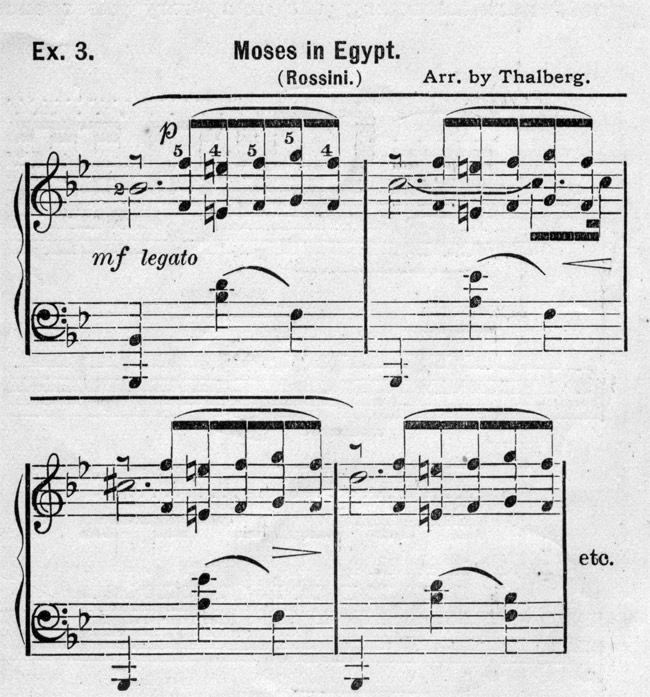
Thalberg’s “Fantasie” on “Themes from Moses in Egypt” deserves mention. It is a somewhat lengthy composition, but there is no danger of monotony if well played, as the succession of themes and moods follow each other in an interesting and effective manner. This number shows the genius of Thalberg for legato melody playing with a delightful and appropriately embellished accompaniment, although some of his variations are undoubtedly old-fashioned. However, that is the case with the opera itself. In this number the composer and the “arranger” are both at their best. On page 6 of the printed copy we find one of the themes in half notes, printed for the right hand (see Illustration III), accompanied by legato octaves for the same hand, which are to be played with the hand (best held level and quiet) while the second or third finger clings to a note of the melody. Small hands should use the fifth finger in the octaves. Von Bülow could make octaves, played with thumb and fifth finger, sound legato through a clinging and curving or “twisting” process with the finger joints. In the more brilliant passage towards the close of the number we see one of the best examples of Thalberg’s style at the piano, for which he was justly celebrated in his time—the treatment of sonorous melody, with brilliant accompaniment, plenty of reach across the keyboard and a liberal use of the damper pedal. The selection shows considerable advance over the “Home, Sweet Home,” for which this composer is so celebrated.
TWO ROSSINI ARRANGEMENTS.
In Liszt’s piano arrangement of the “Cajus Animam” from the “Stabat Mater,” by Rossini, we have all the dignified and religious characteristics of the number, arranged most effectively, still there is no magnifying of difficulties, but just enough elaboration to bring out the true spirit of music in a clear, practical and effective manner. Although we now have an oratorio, instead of an opera transcription, the music has such fine melody and dramatic power that it is worth mentioning in this connection. It is wonderful to observe what massive results and sonority are brought out in this work, by perfectly simple means. It is slow of movement but full of melody and not too difficult for the pianist of medium ability, whose hands are large enough and strong enough to play octaves fairly well.
Among all of Liszt’s arrangements from Italian opera, the ideal single number might be his Fantasie on “Rigoletto” (Verdi). In this number we find the melodious music of the celebrated quartette, which is a favorite number for all the great vocal exponents of “bel-canto.” Liszt’s introduction brings in snatches from the favorite melodic subjects heard during the quartette. (See illustration IV.) This piece is beautiful enough to appear on the programs of some of the great concert pianists of the present day. I once heard Oscar Raif play it beautifully, and Busoni played it at a recital in Chicago when he first visited America. A cadenza, to which a group of these phrases lead, brings us to the introduction of the well-known tenor theme. (Illustration V.) A splendid climax at the close of this section is completed by a cadenza of sixths for both hands alternating in chromatic progression. This is right at the climax of the section and just before the close of the phrase, where the tenor has his high, sustained note, with which (in Italian opera) he is expected to bring down the house. The next two examples show specimens of the thoroughly artistic manner in which Liszt carries on the vocal part, coupled with embellishments,, which add constantly increasing brilliancy without in any way detracting from the original design of the composer. (Illustrations VI and VII.) The use of brilliant octave passages, running passages and arpeggios, legato and other chord work, give us a rare series of valuable technical exercises as serviceable as any etude to develop good technic. The most important advice to give to young students who would play such beautiful, brilliant numbers is to learn the melodies correctly. Also to learn phrasing, meter, rhythmical and harmonic structure of the underlying parts, temporarily minus the brilliant and showy bravura passages, embellishments, etc. Study the melodies first without any
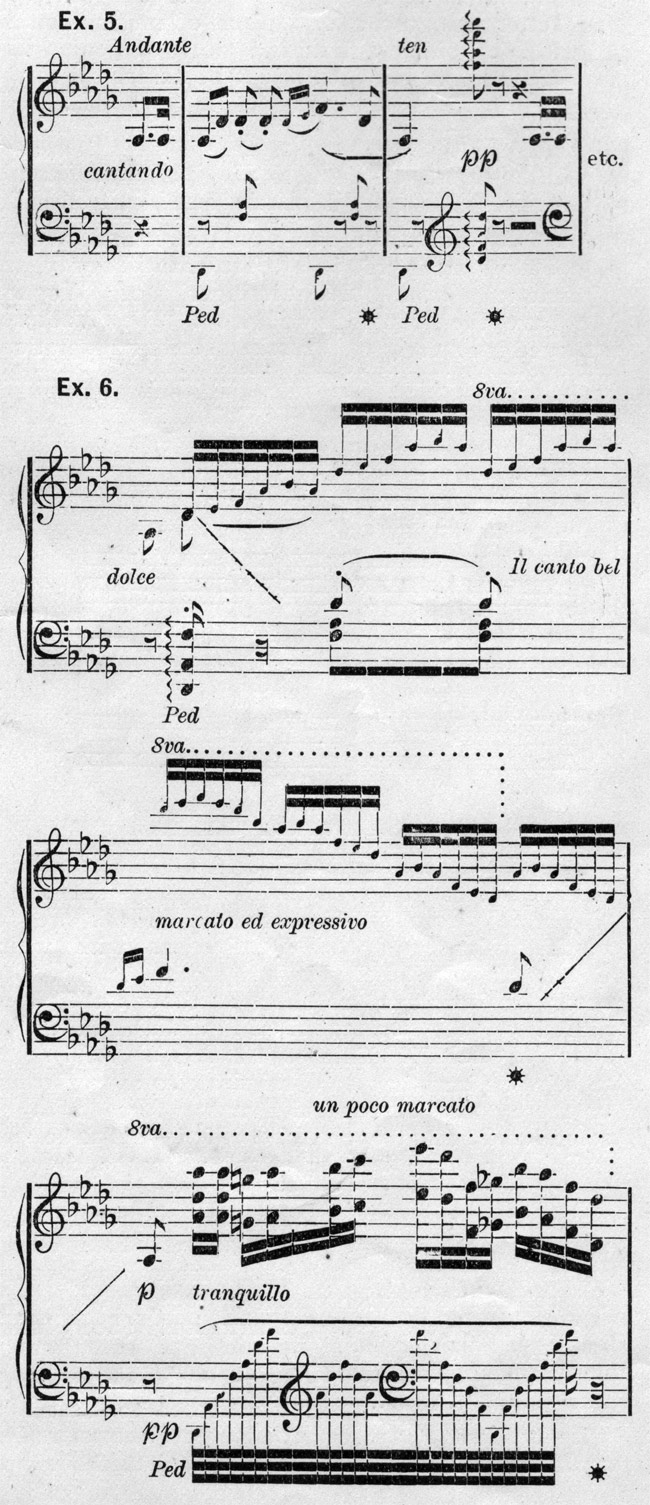
accompaniment, in order to become entirely familiar with their expression and phrasing, as well as their musical and dramatic meaning. If possible, hear them sung by great singers in their original form in the operas; get the opera scores, or at least the piano arrangement for singers, and learn the words, the dramatic situation and study the generally simple accompaniment of bass notes and chords. When afterwards adding the embellishments do so only as you can appreciate their fitting relation to the other parts. Rapid, brilliant runs and passages of arpeggios, thirds, sixths and octaves are not interpretative features of the music, except in a secondary degree and as they ornament the melodies. They should not be used to overwhelm the themes, nor for the sake of displaying your remarkable prowess and your feats of strength and velocity. I have frequently heard some of the most absurd travesties caused in just this manner. The players have not known the themes and have had no conception of the poetry and dramatic effectiveness thereof. But they have played with incomparable boisterousness and lack of taste. On one occasion a young lady pupil brought me such a transcription for a lesson. She played with much brilliancy, clearness and good touch; she was equal to the emergency with octaves and runs; she used the damper pedal well and had a tolerable conception of dynamic proportions in regard to rhythm, accent and otherwise, but she did not know the theme, nor even that there was any such melody in the piece. The effect of her playing was incredibly strange. I began to try to set her right. I first left off every ornament, every chord and at first every bass note, and attempted- to play and sing the phrases of melody with connected meaning. I thought I had made the composition, as a piece of music, clear to this de serving student. She was not one of the bombastic class that a music teacher learns to dread, and whose sins against art can never be settled for in this present world. She returned at the next lesson and played the piece with more perfect execution and still better touch, but again failed to find a connected melody or the phrasing and general meaning thereof. After once more making a very thorough attempt my efforts finally met with success, but it required a great deal of effort and self-denial for her to refrain from brilliant playing long enough to work out the artistic interpretation intelligently.
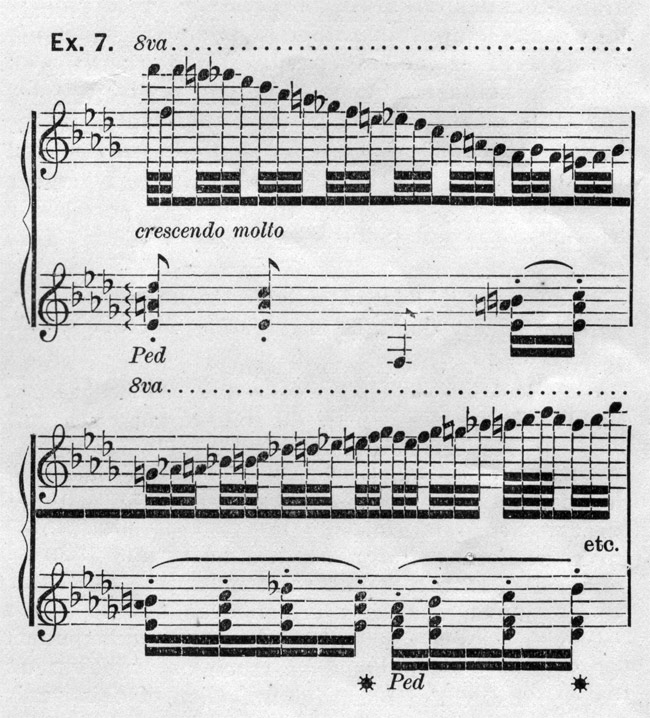
It is easy to overload such compositions with embellishments and brilliancy. Liszt appreciated the spirit of every work that he arranged, so that his embellishments and brilliant passages (like those of Chopin) appear to grow out of the theme itself and enhance its meaning and beauty, rather than to dispute the field with conflicting and ill-fitting “variations.” It is worth while for every concert pianist to have such numbers in his repertory, not only because he can please all of his hearers, thereby including the lady who asked me if Verdi was the greatest composer, as well as those devoted to Bach and Beethoven. He can also do much to improve his execution and elevate his artistic style in piano playing by studying such numbers.



